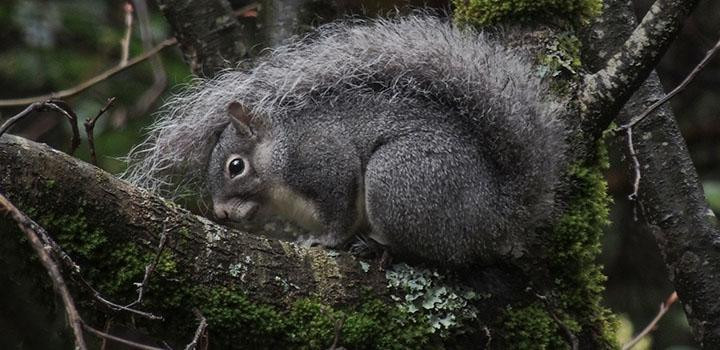
Western Grey Squirrel
Posted by Grange Co-op on 13th Dec 2014
Male & Female: They have grey backs with numerous white tipped hairs and a white belly. The backs of their ears turn reddish-brown in winter and they have long bushy tails with bands of grey white and black. They have very good eyesight even in dim light, and a wide field of vision. They also have a well developed sense of smell and hearing. They undergo a complete head- to -tail molt in the spring and a head- to- rump (not tail) molt in the fall. The tail is replaced only in the spring when the mother squirrels use their tail hair to line birthing nests.
 NESTING:
NESTING:
They mate over an extended period ranging from December through June. Females only have one litter per year in dreys, which are round conspicuous twig and leaf nests built in the upper 1/3 of the canopy of trees. Dreys are waterproof and made of an outer layer of interwoven twigs with a softer inner lining consisting of moss, bark, leaves, fur, feathers, lichen or other similar material. Gestation period is approximately 44 days with litter sizes ranging from 3-5 kits. The kits are born without hair and stay in the nest for 6 months or more, longer than other squirrels. Young grey squirrels have furled tails which won’t reach fullness until adulthood, making this a good indication of age and maturity.
FEEDING:
Western Grey Squirrels are tree or arboreal squirrels and generalist feeders. They feed mainly on seeds, particularly pine cone seeds, acorns and other nuts, some fungi, berries, and occasionally insects. One of their favorites at backyard feeders is corn on the cob that is dried and hung out for them. They also tend to monopolize sunflower seed feeders when available. Food consumption peaks in summer or autumn and decreases in winter. They are scatter-hoarders making numerous caches of food when it is abundant, and thus contribute to the seed dispersion of the food trees.
HABITAT:
They are forest dwellers and can be found in the Pacific States from Washington to California. They are non-territorial and have small overlapping home ranges. They are active year round during the daytime.
OTHER INTERESTING FACTS:
They are highly adapted for climbing trees and fatal falls are rare. Adaptations for climbing trees include tough curved claws and the ability to leap considerable distances, both vertically and horizontally. Tails are used for balance when running and leaping between trees, and held over the back at rest. They are prey for bobcats, hawks, eagles, cougar, coyotes, and cats. Their alarm call is a bark.
